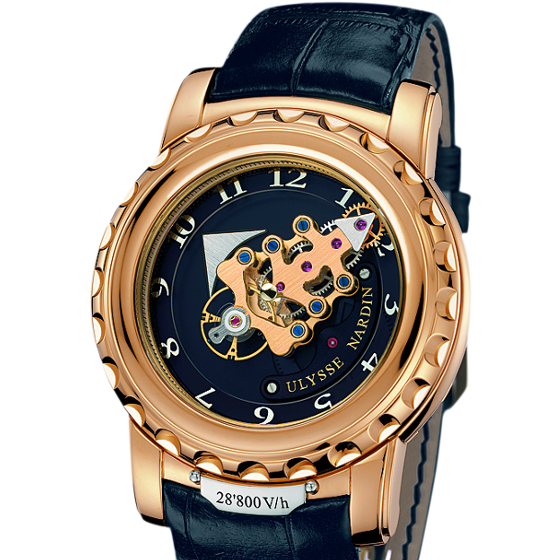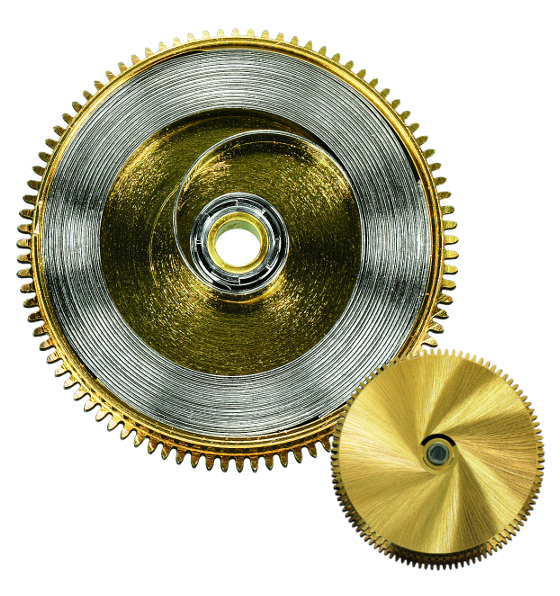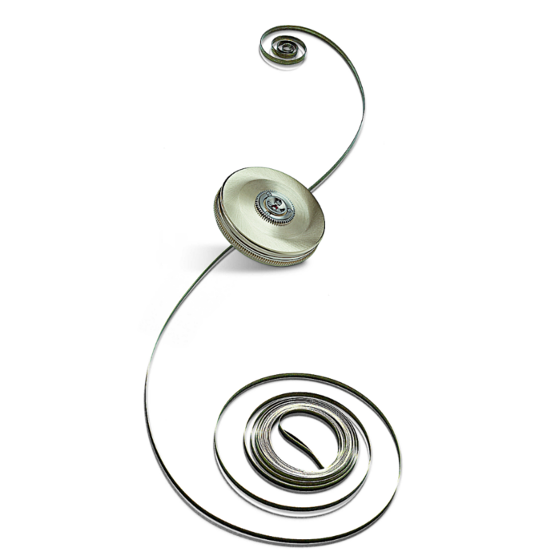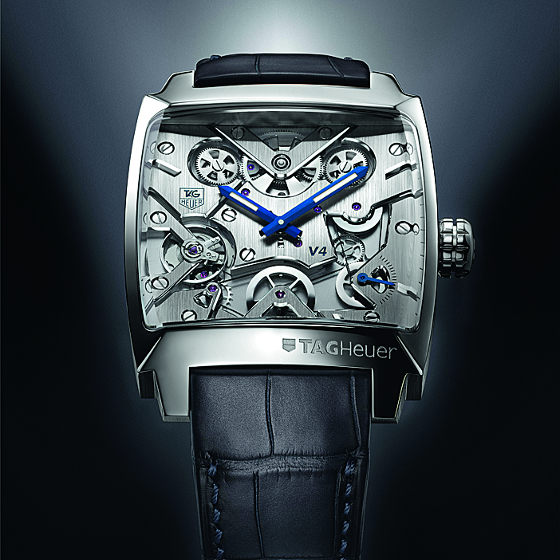In this in-depth feature,best Rolex replica watches expert Gisbert L. Brunner explained that mainsprings perform herculean tasks. With a maximum thickness of just 75/1,000 mm, they develop strong torque, which they keep almost constant.
A mainspring’s torque is directly proportional to its width. Doubling a mainspring’s thickness increases its torque approximately eight times. Its length also influences the movement’s running autonomy: each millimeter added to a mainspring’s length extends the movement’s running time but simultaneously causes a linear decrease in its torque. Building movements that ensure uniformly strong driving torque and long running time poses a special challenge for watchmakers.
Mainsprings must satisfy diverse requirements. They must not become weakened, bend out of shape, kink or (heaven forbid) break. They should also resist corrosion and magnetism. Around 1965, the carbon steel used to make mainsprings began to be replaced with cold-rolled alloys that were less vulnerable to friction and wear. Mainsprings made with these alloys rarely suffer any of the problems listed above.
Nivaflex is the alloy most frequently used for mainsprings in high quality Rolex replica watches today. Nivaflex mainsprings are antimagnetic and have an extremely high tensile strength of up to 3,000 megapascals (equivalent to 300,000 meters). They attain values of 800 or greater on the Vickers hardness scale. (For comparison, 316L stainless steel ranges between 200 and 240 Vickers in hardness.) They are highly resistant to reverse bending, retain good temperature stability in a range from -50 to +350 degrees Celsius, and are exceedingly resistant to corrosion. By weight, Nivaflex consists of 45 percent cobalt, 21 percent nickel, 18 percent chrome, five percent iron, four percent tungsten, four percent molybdenum, one percent titanium and 0.2 percent beryllium; carbon accounts for less than 0.1 percent of this alloy’s weight. Increasing the percentage of beryllium in an alloy further increases its strength and hardness, factors that are important for miniaturization.
For a mainspring to perform at its best, it not only should be made from an alloy like Nivaflex, it also should have a specially constructed end and bridle. The bridle holds the outer end of the mainspring against the inner wall of the barrel. As the mainspring gradually unwinds, the bridle coaxes it into the most nearly concentric shape around the barrel arbor. The barrel of a watch is the fuel tank of its movement. Without a barrel, no wheel in a watch’s mechanism would turn.
Friction between coils must be reduced to maintain a mainspring’s performance. In hand-wound watches, the mainspring is attached to the inside of the barrel near the outer end (but not at the extreme end) of the mainspring. For a self-winding watch, a stationary connection between the mainspring and the barrel would not work because energy is continually flowing toward the mainspring while the watch is on its wearer’s moving wrist. The connection used instead is the “slipping mainspring” or “slipping bridle” device that was patented by Jean-Adrien Philippe, of Patek Philippe, in 1863, before self-winding wristwatches appeared. (The device was designed to wind two mainspring barrels simultaneously.) In this configuration, the mainspring is attached to a circular expansion spring (the bridle), which presses against the inside wall of the barrel. The device prevents overwinding: with a little help from this precisely calculated sliding spring, the mainspring can first accumulate its maximum tension and then dispose of excess tension through the friction generated when the bridle glides along the inner wall of the barrel.
One of the advantages of the mainspring’s coiled shape is a more nearly equal distribution of tension along the entire length of the spring, which goes hand in hand with relatively constant torque. A fully wound mainspring provides very strong driving torque, and a mainspring in its middle range between fully wound and totally exhausted delivers a relatively constant level of torque. The force declines significantly as the mainspring’s tension lessens.
The barrel and the mainspring inside it play a fundamental role in the design of every movement. The center of a classically constructed caliber is occupied by the hour wheel and the cannon pinion, so the maximum diameter of the barrel is limited by the radius of the plate. The barrel’s rotational speed defines the loss of torque during the first 24 hours after the mainspring has been fully wound. Afterward the mainspring in a hand-wound cheap Breitling replica watches is usually given a complete tightening.
A small translation ratio to the center wheel’s pinion and fast rotations of the barrel combine to minimize loss of torque. A typical mainspring should unwind after eight to 10 turns. From these parameters, engineers calculate the ideal thickness of the mainspring, which should fill half to 55 percent of the barrel. Torque arriving at the escape wheel should decline by no more than 15 percent the first day. The calculation of the entire gear train is oriented using these criteria so the watch’s movement runs at a regular rate.
The frequency of the balance plays an essential role in all calculations. As the balance’s frequency increases, the movement’s running autonomy decreases. Skillful construction can achieve up to a week’s running autonomy with only one barrel: the Swiss company Hebdomas proved this in 1913, when it introduced a watch with a big barrel that covered the entire movement. Ulysse Nardin used a similar construction in its Freak in 2001. The 1930s saw the advent of eight-day movements with standard barrels, modified gear trains and tiny balances paced at a frequency of 2.5 hertz. Today’s four-hertz rapid oscillators can usually run for 72 hours without a fresh dose of energy. IWC’s Calibers 51011, 51111 and 59210 demonstrate that a single barrel and a balance paced at 28,800 vph can achieve a full week of running autonomy.
Dividing the driving torque between two mainsprings is by no means a new idea. Henri Louis Jaquet-Droz employed this technique as early as 1785. Abraham-Louis Breguet also devoted considerable attention to optimizing the energy supply for his chronometers: two barrels acting simultaneously on one center pinion not only replaced the conventional chain-and-fusée system, they also enabled Breguet to reduce the mainspring’s thickness by half. The Favre-Leuba company caused a small furor in the Rolex replica watches for sale world when it debuted its three-mm-slim caliber family 25x and 27x in 1962: both movements were hand wound and, similar to Breguet’s invention, each had two barrels acting on the center pinion. The thickness – or rather the thinness – of the springs was quite impressive: each was a mere 0.05 mm thick, yet produced 9 1/4 barrel rotations and approximately 40 hours of running autonomy. The advantages lie in reducing one-sided bearing pressure on the minutes wheel and in the fact that thinner mainsprings develop their force more uniformly. On the other hand, the height increases with parallel switching of two barrels and their collaborative action on the center pinion.
Glashütte master watchmaker Alfred Helwig took a different approach. He relied on a pair of serially switched barrels that act one after the other. After the first mainspring has been fully wound, it then begins to tighten its counterpart. This arrangement doubles the overall length of the springs. Longines first used this principle in its caliber family 89x with two piggyback barrels in 1975. The subsequent Caliber L990 was much slimmer, partly because its two barrels were positioned side by side. The advantages of two quickly rotating energy reservoirs are apparent: lower torque reduces the forces acting on the gear trains while simultaneously enhancing performance. The winding mechanism can work more efficiently in self-winding movements. Partly because of these advantages, this principle can be found increasingly in new constructions. Running time also increases when the length of one mainspring is added to that of its companion. Depending on the details of their construction, most of these calibers run for two to eight days. The pinnacle was reached by A. Lange & Söhne and its Caliber L.034.1 in the Lange 31, which can run for 31 days without a fresh dose of energy.
Panerai installed three serially arranged barrels in Calibers P.2002, P.2003, and P.2004, which resulted in a minimum of eight days of running autonomy. Blancpain followed suit in automatic Calibers 5235DF and 6938, each of which achieves 192 hours of running autonomy. Chopard packed a quartet of barrels into the L.U.C Quattro: four mainsprings, each 470 mm long, give Caliber L.U.C 1.98 a running time of at least 216 hours, or nine days. Vacheron Constantin’s tourbillon Caliber 2253 runs for 14 days with one winding. TAG Heuer’s linearly self-winding Caliber V4 has 52 hours of running autonomy.
Enrico Barbasini, Michel Navas and Mathias Buttet, founders of the now defunct Swiss movement maker BNB Concept SA, joined with Jacob & Co. to create its hand-wound Quenttin tourbillon with Caliber 5 that has a frequency of three hertz, seven barrels arranged side by side, and 31 days of running autonomy.
Far more important than increasing the number of barrels is the technical evolution of the energy reservoir per se. With an overall concept designed to maximize energy efficiency, Cartier’s concept cheap Rolex replica watches, the ID Two, achieves more than a month of running autonomy with four normal-sized, polymer-coated barrels made of fiberglass-reinforced material.








